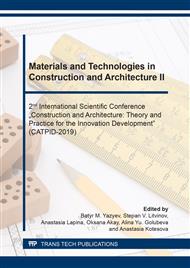p.638
p.646
p.653
p.659
p.665
p.672
p.676
p.681
p.687
Effect Bonding Strength Steel Reinforcement with Epoxy Coating on the Character Destruction of Autoclaved Aerated Concrete Beams in Bending
Abstract:
Many of the complex reinforced Autoclaved Aerated Concrete characteristics under shear and flexure are yet to be identified to employ this material advantageously and economically, as it has many advantages of low weight, fire resistance, acoustic and thermal insulation. It is observed in the article that under two-points loading system, diagonal cracks are usually the first cracks to be observed in the deep beam clear span. The diagonal cracks first are developed in relatively deep beams and the flexural cracks are first developed in shallower beam. The principal mode of failure in the deep beams having adequate reinforcement is diagonal tension cracking. The shear failure is a common type for all beams. This indicates a weak the bond strength between lightweight concrete and reinforcing steel. There are many factors affecting the bond strength between the lightweight concrete and reinforcing steel, where the compressive strength plays an important role in bond strength, and the bond strength is increased by increasing the compressive strength. The AAC beams have the potential to be an excellently energy-saving construction material and is believed to emerge as an alternative to traditional reinforced concrete beam in the near future. This is proved by the experimental analysis.
Info:
Periodical:
Pages:
665-671
Citation:
Online since:
December 2019
Price:
Сopyright:
© 2020 Trans Tech Publications Ltd. All Rights Reserved
Share:
Citation:


